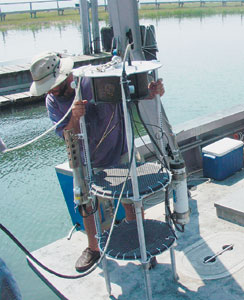What's new in exploration
Seafloor fuel cells. Seafloor sensors require power to operate. For intermittent sensing, conventional or permanently installed ocean-bottom sensors can be powered by an acquisition vessel, producing platform or shore-based installation. However, continuous seafloor monitoring – such as needed for military or scientific use – requires constant power. A novel way to produce power on the seafloor has been discovered. It’s essentially an underwater fuel cell that runs on seawater and subsea sediment. It can generate small amounts of electricity indefinitely. Called OSCAR, for Ocean Sediment Carbon Aerobic Reactor, the cell exploits a natural voltage difference created by a pair of chemical reactions occurring on the seabed. Plankton release energy by using oxygen to break down organic matter in seawater or sediment. Unlike seawater, there is little or no oxygen within sediment, so plankton therein use different chemical reactions. These two reactions create a voltage difference between the seawater and sediment a few centimeters beneath the seafloor. Jointly funded by the U.S. Office of Naval Research (ONR) and the Defense Advanced Research Projects Agency, researchers are trying to harness this energy to power small, remote seafloor instruments. "Obviously, the bigger and more efficient the fuel cell electrodes are, the more power you’ll get," explains Dr. Harold Bright, ONR program manager for OSCAR and a co-inventor of the device. "OSCAR’s unique advantage, compared to state-of-the-art sea batteries, is that it can produce small levels of power continuously and indefinitely." The cell’s power is continuous because sediment is constantly flushed and replaced as plankton die. The experimental power cell is currently operating offshore New Jersey, generating 50 milliwatts of power at about 0.7 volts from electrodes covering 1 m2. A prototype logged 224 days of continuous power output. The cell’s performance, which will improve with further development, can be monitored live at http://209.158.75.87/shorestation.htm. Applications for real-time monitoring of offshore oil and gas reservoirs are obvious.
Frontier discovery. Amerada Hess had a significant discovery on License 001 in the Faroe Islands. A gross interval comprising about 560 ft of light oil and gas was discovered in Well 6004/16-1 – the first discovery offshore the Faroes. The discovery is based on log data, because weather conditions prevented a flow test. The well is being P&A’d while further drilling delineates the field. Commenting on the discovery, Amerada Hess UK Managing Director Nick Fairbrother said, "This is a great result. We’re delighted that our first well in the Faroes has been successful, and we look forward to following up on this success with our drilling program next year." The well is located close to the UK boundary in 3,100 ft of water. The initial well section was drilled to its planned TD of 12,560 ft and funded by the Faroes Partnership (Amerada Hess, 43%; BG Int’l, 40%; DONG, 17%; and Atlantic Petroleum, the independent Faroese-owned company, 0.1%, with options to increase its ownership). Fortunately, a subsequent decision pushed TD to 14,026 ft, under sole-risk provisions of the partnership agreement, which eliminated BG’s participation in the deeper section. The discovery came just a couple of months after exploratory wells drilled in the same area by other oil companies produced disappointing results. West of ANWR. While the battle rages over exploring in the Alaska National Wildlife Refuge, Phillips Petroleum and partner Anadarko are increasingly looking westward. They have applied for permits to drill about a dozen exploratory wells in the National Petroleum Reserve-Alaska, west of Prudhoe Bay and Kuparuk. Phillips will likely drill up to six wells, while Anadarko is seeking permission to drill its own well there. The companies have also applied for permits to drill wells on state land south of Kuparuk field. Located about 60 mi west of Prudhoe Bay, the 23-million-acre reserve was explored sporadically beginning in the 1940s, mostly by government agencies, but only recently has it gained serious attention. In 1995, after several years of exploring the Colville River Delta area, Arco and its partners at the time, Anadarko and Union Texas, discovered the 430-million-bbl Alpine field on state land about 30 miles west of Kuparuk. Alpine is now the North Slope’s westernmost operating field. Production started last year and, at 92,000 bopd, is now 10,000 bopd above earlier expectations. Phillips Alaska President Kevin Meyers stated in May that the company had found significant accumulations of oil and condensate at three prospects in NPRA. Farther west of Prudhoe bay, "is where the action is," said Chuck Logsdon, chief petroleum economist for the Alaska Department of Revenue. "Alpine was kind of the kicker to moving farther west. When they discovered that, they went back and rethought a lot of things they were looking for." In 1999, the Bureau of Land Management held a lease sale, offering about 4-million acres in the northeast corner of NPRA, which drew $104.6 million in bids. The agency is planning a sale next June to re-offer tracts not leased in 1999. After that, the BLM foresees holding a lease sale every two years. The agency has begun work on a land-use plan for an additional 10 million acres in the northwestern part of the federal reserve. (Story adapted from a Reuters report.)
|




